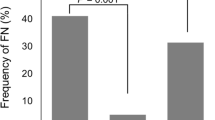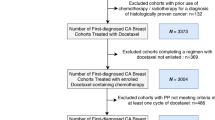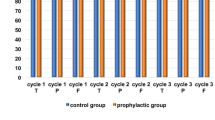Abstract
Purpose
Epirubicin and cyclophosphamide (EC) therapy, a major chemotherapy for patients with early-stage breast cancer, has a low risk (< 10%) of febrile neutropenia (FN). However, data used in reports on the incidence rate of FN were derived primarily from non-Asian populations. In this study, we investigated the FN incidence rate using EC therapy among Japanese patients with breast cancer and evaluated the significance of prophylactic administration of granulocyte colony-stimulating factor (G-CSF).
Methods
We evaluated medical records of patients with early-stage breast cancer who had been treated with EC therapy as neoadjuvant or adjuvant therapy between November 2014 and July 2018.
Results
The incidence rate of FN was 23.9%. In patients who received G-CSF as primary prophylaxis, FN expression was completely suppressed. The incidence rate of severe leucopenia/neutropenia, emergency hospitalization, and the use of antimicrobial agents were low in patients receiving primary prophylaxis with G-CSF compared with those not receiving G-CSF (27.3% vs. 64.8%, 9.1% vs. 27.3%, and 27.3% vs. 71.6%, respectively). Furthermore, in all patients who received primary prophylaxis with G-CSF, a relative dose intensity > 85% using EC therapy was maintained.
Conclusion
The incidence of FN in EC therapy among Japanese patients was higher than expected, EC therapy appears to be a high-risk chemotherapy for FN, and prophylactic administration of G-CSF is recommended. Maintaining high therapeutic intensity is associated with a positive prognosis for patients with early breast cancer, and prophylactic administration of G-CSF is likely to be beneficial in treatment involving EC therapy.



Similar content being viewed by others
References
Weycker D, Barron R, Edelsberg J, Kartashov A, Lyman GH (2012) Incidence of reduced chemotherapy relative dose intensity among women with early stage breast cancer in US clinical practice. Breast Cancer Res Treat 133:301–310
Link BK, Budd GT, Scott S, Dickman E, Paul D, Lawless G, Lee MW, Fridman M, Ford J, Carter WB (2001) Delivering adjuvant chemotherapy to women with early-stage breast carcinoma: current patterns of care. Cancer 92:1354–1367
Lyman GH, Dale DC, Crawford J (2003) Incidence and predictors of low dose-intensity in adjuvant breast cancer chemotherapy: a nationwide study of community practices. J Clin Oncol 21(24):4524–4531
Epelbaum R, Haim N, Ben-Shahar M, Ron Y, Cohen Y (1988) Dose-intensity analysis for CHOP chemotherapy in diffuse aggressive large cell lymphoma. Isr J Med Sci 24:533–538
Bonadonna G, Valagussa P, Moliterni A, Zambetti M, Brambilla C (1995) Adjuvant cyclophosphamide, methotrexate, and fluorouracil in node-positive breast cancer: the results of 20 years of follow-up. N Engl J Med 332:901–906
Chirivella I, Bermejo B, Insa A, Perez-Fidalgo A, Magro A, Rosello S, Garcia-Garre E, Martin P, Bosch A, Lluch A (2009) Optimal delivery of anthracycline-based chemotherapy in the adjuvant setting improves outcome of breast cancer patients. Breast Cancer Res Treat 114:479–484
Lyman GH, Michels SL, Reynolds MW, Barron R, Tomic KS, Yu J (2010) Risk of mortality in patients with cancer who experience febrile neutropenia. Cancer 116:5555–5563
Kosaka Y, Rai Y, Masuda N, Takano T, Saeki T, Nakamura S, Shimazaki R, Ito Y, Tokuda Y, Tamura K (2015) Phase III placebo-controlled, double-blind, randomized trial of pegfilgrastim to reduce the risk of febrile neutropenia in breast cancer patients receiving docetaxel/cyclophosphamide chemotherapy. Support Care Cancer 23:1137–1143
Blohmer JU, Schmid P, Hilfrich J, Friese K, Kleine-Tebbe A, Koelbl H, Sommer H, Morack G, Wischnewsky MB, Lichtenegger W, Kuemmel S (2010) Epirubicin and cyclophosphamide versus epirubicin and docetaxel as first-line therapy for women with metastatic breast cancer: final results of a randomised phase III trial. Ann Oncol 21:1430–1435
Untch M, Muscholl M, Tjulandin S, Jonat W, Meerpohl HG, Lichinitser M, Manikhas AG, Coumbos A, Kreienberg R, du Bois A, Harbeck N, Jackisch C, Muller V, Pauschinger M, Thomssen C, Lehle M, Catalani O, Luck HJ (2010) First-line trastuzumab plus epirubicin and cyclophosphamide therapy in patients with human epidermal growth factor receptor 2-positive metastatic breast cancer: cardiac safety and efficacy data from the Herceptin, Cyclophosphamide, and Epirubicin (HERCULES) trial. J Clin Oncol 28:1473–1480
Eckhoff L, Nielsen M, Moeller S, Knoop A (2011) TAXTOX—a retrospective study regarding the side effects of docetaxel given as part of the adjuvant treatment to patients with primary breast cancer in Denmark from 2007 to 2009. Acta Oncol 50:1075–1082
Margolin S, Bengtsson NO, Carlsson L, Edlund P, Hellstrom M, Karlsson P, Lidbrink E, Linderholm B, Lindman H, Malmstrom P, Pettersson Skold D, Soderberg M, Villman K, Bergh J (2011) A randomised feasibility/phase II study (SBG 2004-1) with dose-dense/tailored epirubicin, cyclophosphamide (EC) followed by docetaxel (T) or fixed dosed dose-dense EC/T versus T, doxorubicin and C (TAC) in node-positive breast cancer. Acta Oncol 50:35–41
Schonherr A, Aivazova-Fuchs V, Annecke K, Juckstock J, Hepp P, Andergassen U, Augustin D, Simon W, Wischnik A, Mohrmann S, Salmen J, Zwingers T, Kiechle M, Harbeck N, Friese K, Janni W, Rack B (2012) Toxicity analysis in the ADEBAR trial: sequential anthracycline–taxane therapy compared with FEC120 for the adjuvant treatment of high-risk breast cancer. Breast Care (Basel) 7:289–295
Martin M, Ruiz Simon A, Ruiz Borrego M, Ribelles N, Rodriguez-Lescure A, Munoz-Mateu M, Gonzalez S, Margeli Vila M, Barnadas A, Ramos M, Del Barco Berron S, Jara C, Calvo L, Martinez-Janez N, Mendiola Fernandez C, Rodriguez CA, Martinez de Duenas E, Andres R, Plazaola A, de la Haba-Rodriguez J, Lopez-Vega JM, Adrover E, Ballesteros AI, Santaballa A, Sanchez-Rovira P, Baena-Canada JM, Casas M, del Carmen Camara M, Carrasco EM, Lluch A (2015) Epirubicin plus cyclophosphamide followed by docetaxel versus epirubicin plus docetaxel followed by capecitabine as adjuvant therapy for node-positive early breast cancer: results from the GEICAM/2003-10 study. J Clin Oncol 33:3788–3795
Gandara DR, Kawaguchi T, Crowley J, Moon J, Furuse K, Kawahara M, Teramukai S, Ohe Y, Kubota K, Williamson SK, Gautschi O, Lenz HJ, McLeod HL, Lara PN Jr, Coltman CA Jr, Fukuoka M, Saijo N, Fukushima M, Mack PC (2009) Japanese–US common-arm analysis of paclitaxel plus carboplatin in advanced non-small-cell lung cancer: a model for assessing population-related pharmacogenomics. J Clin Oncol 27:3540–3546
Hasegawa Y, Kawaguchi T, Kubo A, Ando M, Shiraishi J, Isa S, Tsuji T, Tsujino K, Ou SH, Nakagawa K, Takada M (2011) Ethnic difference in hematological toxicity in patients with non-small cell lung cancer treated with chemotherapy: a pooled analysis on Asian versus non-Asian in phase II and III clinical trials. J Thorac Oncol 6:1881–1888
Blum JL, Flynn PJ, Yothers G, Asmar L, Geyer CE Jr, Jacobs SA, Robert NJ, Hopkins JO, O’Shaughnessy JA, Dang CT, Gomez HL, Fehrenbacher L, Vukelja SJ, Lyss AP, Paul D, Brufsky AM, Jeong JH, Colangelo LH, Swain SM, Mamounas EP, Jones SE, Wolmark N (2017) Anthracyclines in early breast cancer: the ABC trials-USOR 06-090, NSABP B-46-I/USOR 07132, and NSABP B-49 (NRG Oncology). J Clin Oncol 35:2647–2655
Watanabe T, Kuranami M, Inoue K, Masuda N, Aogi K, Ohno S, Iwata H, Mukai H, Uemura Y, Ohashi Y (2017) Comparison of an AC-taxane versus AC-free regimen and paclitaxel versus docetaxel in patients with lymph node-positive breast cancer: final results of the National Surgical Adjuvant Study of Breast Cancer 02 trial, a randomized comparative phase 3 study. Cancer 123:759–768
Kim CG, Sohn J, Chon H, Kim JH, Heo SJ, Cho H, Kim IJ, Kim SI, Park S, Park HS, Kim GM (2016) Incidence of febrile neutropenia in Korean female breast cancer patients receiving preoperative or postoperative doxorubicin/cyclophosphamide followed by docetaxel chemotherapy. J Breast Cancer 19:76–82
Chan A, Chen C, Chiang J, Tan SH, Ng R (2012) Incidence of febrile neutropenia among early-stage breast cancer patients receiving anthracycline-based chemotherapy. Support Care Cancer 20:1525–1532
Jones SE, Savin MA, Holmes FA, O’Shaughnessy JA, Blum JL, Vukelja S, McIntyre KJ, Pippen JE, Bordelon JH, Kirby R, Sandbach J, Hyman WJ, Khandelwal P, Negron AG, Richards DA, Anthony SP, Mennel RG, Boehm KA, Meyer WG, Asmar L (2006) Phase III trial comparing doxorubicin plus cyclophosphamide with docetaxel plus cyclophosphamide as adjuvant therapy for operable breast cancer. J Clin Oncol 24:5381–5387
Kimura M, Araoka H, Yoshida A, Yamamoto H, Abe M, Okamoto Y, Yuasa M, Kaji D, Kageyama K, Nishida A, Ishiwata K, Takagi S, Yamamoto G, Asano-Mori Y, Uchida N, Hishinuma A, Izutsu K, Wake A, Taniguchi S, Yoneyama A (2016) Breakthrough viridans streptococcal bacteremia in allogeneic hematopoietic stem cell transplant recipients receiving levofloxacin prophylaxis in a Japanese hospital. BMC Infect Dis 16:372
Busca A, Cavecchia I, Locatelli F, D’Ardia S, De Rosa FG, Marmont F, Ciccone G, Baldi I, Serra R, Gaido E, Falda M (2012) Blood stream infections after allogeneic stem cell transplantation: a single-center experience with the use of levofloxacin prophylaxis. Transpl Infect Dis 14:40–48
Jenkins P, Freeman S (2009) Pretreatment haematological laboratory values predict for excessive myelosuppression in patients receiving adjuvant FEC chemotherapy for breast cancer. Ann Oncol 20:34–40
Tang NL, Liao CD, Wang X, Mo FK, Chan VT, Ng R, Pang E, Suen JJ, Woo J, Yeo W (2013) Role of pharmacogenetics on adjuvant chemotherapy-induced neutropenia in Chinese breast cancer patients. J Cancer Res Clin Oncol 139:419–427
Aslani A, Smith RC, Allen BJ, Pavlakis N, Levi JA (2000) The predictive value of body protein for chemotherapy-induced toxicity. Cancer 88:796–803
Rabinowitz AP, Weiner NJ, Tronic BS, Fridman M, Liberman RF, Delgado DJ (2006) Severe neutropenia in CHOP occurs most frequently in cycle 1: a predictive model. Leuk Lymphoma 47:853–858
Sakurada T, Kakiuchi S, Tajima S, Horinouchi Y, Okada N, Nishisako H, Nakamura T, Teraoka K, Kawazoe K, Yanagawa H, Nishioka Y, Minakuchi K, Ishizawa K (2015) Characteristics of and risk factors for interstitial lung disease induced by chemotherapy for lung cancer. Ann Pharmacother 49:398–404
Sakurada T, Kakiuchi S, Tajima S, Horinouchi Y, Konaka K, Okada N, Nishisako H, Nakamura T, Teraoka K, Kawazoe K, Yanagawa H, Nishioka Y, Ishizawa K (2015) Pemetrexed-induced rash may be prevented by supplementary corticosteroids. Biol Pharm Bull 38:1752–1756
Okada N, Hanafusa T, Sakurada T, Teraoka K, Kujime T, Abe M, Shinohara Y, Kawazoe K, Minakuchi K (2014) Risk factors for early-onset peripheral neuropathy caused by vincristine in patients with a first administration of R-CHOP or R-CHOP-like chemotherapy. J Clin Med Res 6:252–260
Acknowledgements
The author(s) received no grants or funding for the research, authorship, and/or publication of this article.
Author information
Authors and Affiliations
Corresponding author
Ethics declarations
Conflict of interest
The authors declare no conflicts of interest.
Additional information
Publisher's Note
Springer Nature remains neutral with regard to jurisdictional claims in published maps and institutional affiliations.
Rights and permissions
About this article
Cite this article
Sakurada, T., Bando, S., Zamami, Y. et al. Prophylactic administration of granulocyte colony-stimulating factor in epirubicin and cyclophosphamide chemotherapy for Japanese breast cancer patients: a retrospective study. Cancer Chemother Pharmacol 84, 1107–1114 (2019). https://doi.org/10.1007/s00280-019-03948-6
Received:
Accepted:
Published:
Issue Date:
DOI: https://doi.org/10.1007/s00280-019-03948-6




